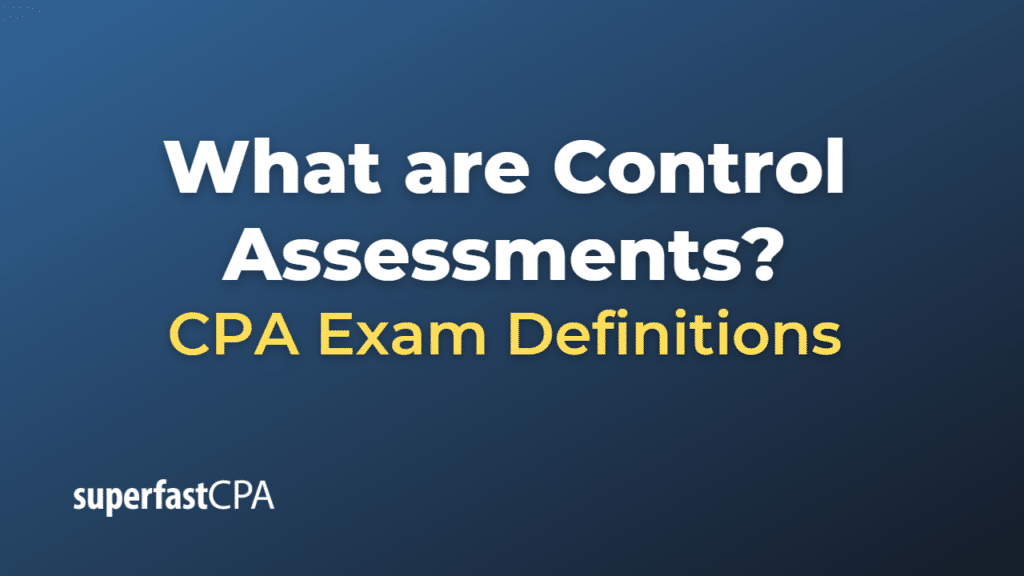Control Assessments
Control assessments are systematic evaluations of an organization’s internal control system, including its policies, procedures, and control activities. The purpose of control assessments is to determine the effectiveness of the internal controls in managing risks, ensuring the accuracy and reliability of financial and operational information, preventing fraud, and maintaining compliance with laws, regulations, and internal policies.
Control assessments can be performed by internal or external parties, depending on the organization’s needs and objectives:
- Internal assessments: These are conducted by the organization’s own personnel, such as internal auditors, risk management teams, or process owners. Internal assessments can be part of a regular, ongoing monitoring process or a periodic, comprehensive review of the internal control system.
- External assessments: These are performed by independent, third-party professionals, such as external auditors or consultants. External assessments typically focus on specific areas of the internal control system, like financial reporting or regulatory compliance, and may be required by regulators, investors, or other stakeholders.
Control assessments generally involve the following steps:
- Identifying risks: Assessors start by identifying the key risks that the organization faces in achieving its objectives, such as financial, operational, strategic, or compliance risks.
- Evaluating control design: Assessors evaluate the design and structure of the internal control system to determine if it is appropriately designed to address the identified risks. This includes reviewing policies, procedures, and control activities to ensure they are relevant, comprehensive, and aligned with the organization’s objectives.
- Testing control effectiveness: Assessors test the effectiveness of the internal controls by reviewing documentation, conducting interviews, performing walkthroughs, and observing control activities in action. They may also perform sample-based testing to verify the accuracy and completeness of financial and operational records.
- Identifying control deficiencies: If assessors identify any weaknesses or gaps in the internal control system, they document these as control deficiencies. Control deficiencies can range from minor weaknesses, which may not have a significant impact on the organization’s objectives, to material weaknesses, which could lead to material misstatements in financial reporting or non-compliance with laws and regulations.
- Recommending improvements: Based on the results of the control assessment, assessors may recommend improvements to the internal control system, such as updating policies and procedures, implementing new control activities, or providing additional training to employees.
- Monitoring and follow-up: Once improvements have been implemented, assessors may conduct follow-up assessments to ensure that the internal control system is functioning effectively and that control deficiencies have been adequately addressed.
In summary, control assessments are systematic evaluations of an organization’s internal control system, aimed at determining the effectiveness of the controls in managing risks, ensuring the accuracy and reliability of financial and operational information, preventing fraud, and maintaining compliance with laws, regulations, and internal policies. Control assessments can be performed by internal or external parties and may involve identifying risks, evaluating control design, testing control effectiveness, identifying control deficiencies, recommending improvements, and monitoring the implementation of improvements.
Example of Control Assessments
Let’s consider a hypothetical example of a manufacturing company that decides to conduct an internal control assessment to evaluate the effectiveness of its internal control system in managing risks and ensuring the accuracy and reliability of its financial and operational information.
- Identifying risks: The internal control assessment team starts by identifying the key risks that the company faces, such as:
- Financial risks: Inaccurate financial reporting, mismanagement of cash flow, or unauthorized transactions.
- Operational risks: Production inefficiencies, equipment failures, or supply chain disruptions.
- Compliance risks: Non-compliance with environmental regulations, labor laws, or tax requirements.
- Evaluating control design: The assessment team reviews the company’s policies, procedures, and control activities to determine if they are appropriately designed to address the identified risks. For example, they might evaluate the segregation of duties within the finance department, the authorization and approval processes for purchasing and inventory management, and the procedures for monitoring regulatory compliance.
- Testing control effectiveness: The team tests the effectiveness of the internal controls by reviewing documentation, conducting interviews with employees, performing walkthroughs of key processes, and observing control activities in action. They might also perform sample-based testing, such as selecting a sample of sales transactions to verify that they have been properly authorized, recorded, and supported by appropriate documentation.
- Identifying control deficiencies: During the assessment, the team identifies several control deficiencies, including:
- Inadequate segregation of duties within the finance department, which could lead to errors or fraud.
- Lack of formal approval processes for certain purchasing and inventory management activities, which could result in unauthorized or unnecessary expenditures.
- Insufficient monitoring of compliance with environmental regulations, which could expose the company to fines, penalties, or reputational damage.
- Recommending improvements: Based on the identified control deficiencies, the assessment team recommends several improvements to the company’s internal control system, such as:
- Implementing additional segregation of duties within the finance department by assigning different tasks to different employees.
- Establishing formal approval processes for purchasing and inventory management activities, with clear authorization levels and documentation requirements.
- Enhancing the monitoring of environmental compliance by conducting regular internal audits, providing additional training to employees, and implementing a robust reporting system for compliance-related issues.
- Monitoring and follow-up: After the company implements the recommended improvements, the assessment team conducts a follow-up assessment to ensure that the internal control system is functioning effectively and that the control deficiencies have been adequately addressed.
In this example, the manufacturing company has conducted an internal control assessment to evaluate the effectiveness of its internal control system, identify control deficiencies, and implement improvements to better manage risks and ensure the accuracy and reliability of its financial and operational information.













